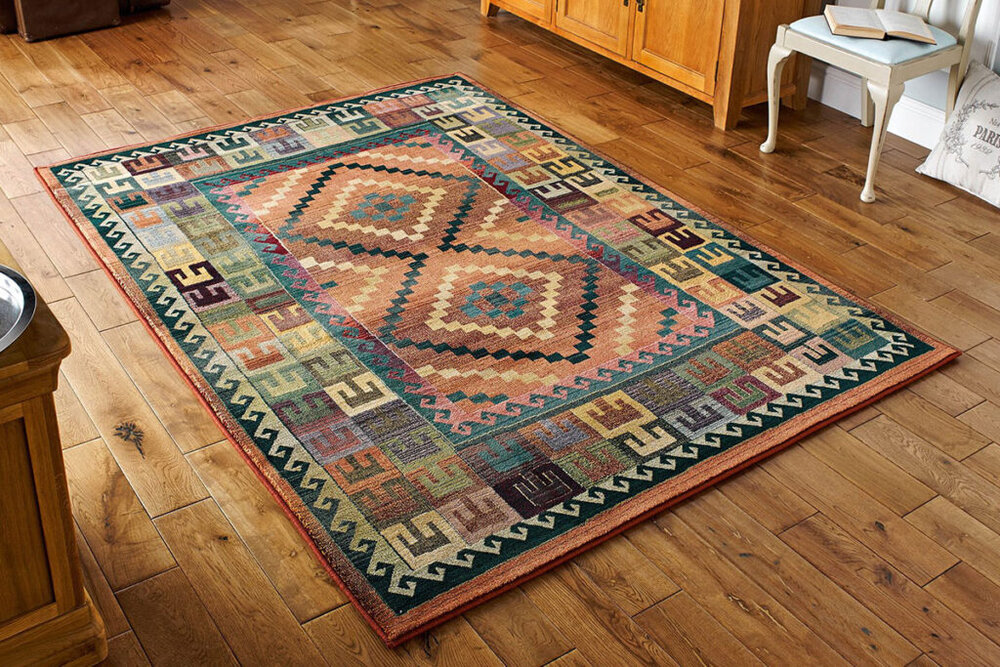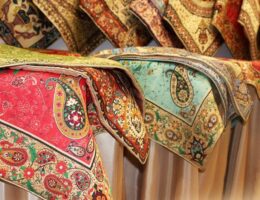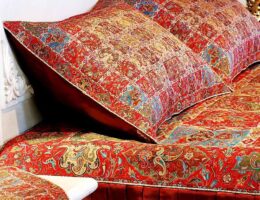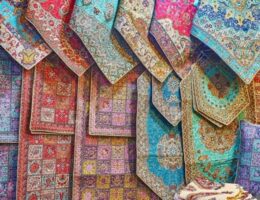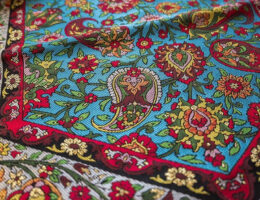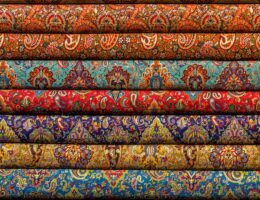IRAN ART EXHIBITION: WHAT IS GABBEH? AND HOW IS IT MADE?
Gabbeh (from the Persian language farsi; raw, natural, uncut) represents a rough and primitive carpet with patterns mostly made by Ghashghai nomads from the Farsi province in the southwest of Iran. These carpets are probably the most well-known handmade carpets from Iran. They are manufactured by handspun wool, both in the pile and warp, and the yarns are dyed using plant dyes. The carpets are much thicker than other Persian carpets, sometimes up to 2.5 cm thick.
The patterns of the carpet are of a simple type with only a few elements of decorative, mostly rectangular objects containing animals. During the last decades, the weavers have had to meet the demands of the west and have therefore, resorted to using large light fields with chary pattering in the Gabbeh carpets.
Weavers from India have acted quickly to copy these carpets, but one must pay attention to this as there is a major difference between a Persian and a Indo Gabbeh carpet. Mostly this can be determined by the quality of the wool that is noticeable, the Persian variant is much softer. The Persian variant is also much more durable and the quality is definitely better.
At present, there are different names given to Gabbeh carpets such as Basic, Amalehbaft, Kashkooli, Luribaft, Sumak and Baluch Gabbeh. A Gabbeh Kashkooli is a carpet with a higher knot density and a shorter pile than the usual Gabbeh carpets.
Gabbeh rug is a kind of Persian rug. It is also called Gabba. It is a thick , hand-knotted with tall pile height Persian rug. The pile height reaches to 15 millimeter.
The size of knots are coarse and they have medium size. The most common size of Gabbeh is 1.5 meter by 2 meter. It means 3 square meter. Other common sizes include 2 by 3 and 3 by 3 meter.
The design and patterns of these rugs are simple colors. These rugs are woven in Zagros mountains and nomads of Iran. These rugs are thicker and tougher than Persian rugs. They are woven by women. Their patterns have been consist of simple objects like rectangular or animals.
Their color is usually red , green , brown , and blue or grey. the material of these kind of rugs are natural wool of sheep and the color of them are made of natural dye. Since they are crafted much easier than carpets so their price is low and affordable in comparison with Persian rugs which are knotted in Tabriz or other areas. Gabbehs are heavy and have high depth. Gabbeh rugs cover part of the room and help to decorate a complex room to change the style.
Recently many European countries have welcomed these kind of carpets and they have a relatively extensive market. These floor coverings We have brought different kind of gabbeh rugs from different parts of Iran with one year guarantee. There are several types of Gabbeh which I shall describe it for you. Gabbehs are divided to several categories as below:
Amalehbaf: A kind of rug with course and tighter weaves and have simple designs.
Kashkoli: A kind of carpet that have tighter KPI (Knot Per Inch).
Luribaf: They have complicated shapes and designs.
Baluch: They are flat and have nomad designs.
Sumak: They have more details and full of colors and in fact colorful rugs.
History
The carpet weaving history started 2500 years ago in Persia now it is known Iran.
Persian rugs were initially knotted as a requisite and indispensable floor covering when nomad tribes travel among mountains in Zagros area.
These carpets protected them from cold and damp. This art has been handed down from many years ago during wars and violence up to now from generation to generation.
What is Gabbeh?
Gabbeh is a type of carpet flooring and, like carpet weaving, has a lot of artistic value, which today enthralled countless admirers and patrons everywhere in the world.
IRAN ART EXHIBITION: Some researchers consider the naming of this rug named Gabbeh to be thick and its application is to protect against various factors such as cold.
It can be said that the history of the emergence and production of Gabbeh goes back to the time of the early humans because they first used the skin of different animals as their flooring, and over the time they mastered in producing rugs by domestic animals’ wool which now they are called Gabbeh.
Gabbeh, also known as Khursak Rug, is of the same type as the carpet, with the difference that it is made in smaller sizes and with taller piles, and mainly is the handiwork art of the nomads of different regions such as Bushehr, Shiraz, Khorasan and … and indeed is one of the main culture sources of this People.
It should be noted that the province of Fars with a 150-year-old in the field of Ghabe-weaving can be considered as the pioneers of this art in Iran. This area has nomads such as Eilat Qashqai, Khamseh, Mamasani and Bakhtiari, and it can be said certainty that Ghashgahi Turks weave the best Gabbeh. it also has many patrons around the world. Among the other important centers of the Gabbeh knotting in Iran. we can mention Dogonbadan, the Basht, the Telegar, Cheshmeh Belgaise , Dahsheikh and the Charam in the city of Kohkiluyeh, Borazjan, and the Shul village and Dahkohneh village of Bushehr province.
Gabbeh designs
Lion Design
The lion design can be considered as one of the main roles of the weavers of different regions.
Kheshti Design
This design is one of Gabbeh’s most applicable designs, which is more common among Persian and Bakhtiari knitters. The basis of this design is regular frames, which each of these frames individually connected with other frames.
Fountain design
This design is a Toranj in the middle of the rug, and in fact it’s a flower that has branches and flowers around it.
Flower design
The shape of rose i flowers in Gabbeh is known as the flower design.
Eliati design
This design is based on the nature of nomads’ lifestyle, which is most often found in lozenge, circular, square, rectangular and elliptical frames, and each of these frames is embroidered with Persian designs.
Tree Design
In ancient history of Iran, the tree has always been important, and among them all, the cedar tree is the most used as a symbol of joy and the willow tree as a symbol of grief.
Stripe Design
As the name suggests, it consists of lines that are often vertical and oblique.
house Design
It has a mystical conception of its own, It is a house design and in fact there is a picture of the stages of life from the beginning to the end, which is to reach the essence of being and existence.
Simple plan
It can be said that these simple Gabbehs are depicting peasant homes of their villages and their deserted land.
The difference between Kilim and Gabbeh
Kilim and Gabbeh are exquisite and authentic Iranian rugs that are both tribal and rural woven. But most people who are unfamiliar with the types of rugs and who do not know the difference between the Kilim and the Gabbeh. The difference between the Kilim and the Gabbeh is in their texture and appearance. In this article, we discuss some of the most important differences between them.
The general definition of a Kilim
It does not have pile and is a texture that is made of warp and weft and does not have a long piles like carpet or rug. Its main material is goat or sheep wool. What ever the thinner and softer the texture of the Kilim is, it has better quality. If under neck wool of a sheep or wool of under arms of a sheep or Merinos wool has been used in weaving of a Kilim , it has high quality.
The Kilim weaving has always been in areas where the people of that region were engaged in animal husbandry, such as Turkey, Tibet, Nepal and Turkmenistan.
Geographical factors have always played an important role in the emergence of different designs of the Kilim. The men and women of each region, according to their scope of vision and, of course, the blessings they sought from God, performed in the texture of the Kilim, which can be said to be all imaginary motifs without any pre-designed plan.
For example, the lozenge in some Kilims reflect the flow of water in river or the figure of the sun in so-called sunflower design indicating the blessings of the sun and the fertility of the soil. Or, for example, the Paisley designs that are opposite to each other show resentment and those which are in front of each other represent reconciliation and peace.
We compare Kilim and Gabbeh as follows:
Gabbeh and Kilim sizes are under 6 squaremeters.
Both of them have materials from pure sheep wool.
Their colors are natural.
The weaving of Gabbeh is imaginary but Kilim weaving is imaginary or with pre defined motifs.
Kilim does not have pile but Gabbeh has long piles.
Kilim is weaved in Iran and Turkey but Gabbeh is weaved only in Iran.
The difference between old and modern Gabbehs
IRAN ART EXHIBITION: In the old days, wools were not dyed , meaning that the sheep wool used in their rugs were used without color; these wools were often found in natural, black, white and gray colors, which were based on the weaver’s spirit. They would be For example, if weaver was happy, he would use more white color, and in return if he or she was upset, it would use more black color. Over time, weavers provided more colorful and diverse designs by herbal and natural colors. But nowadays, to expedite the Gabbeh making process, they use chemical paints to color the wool.
Bakhtiari Gabbeh
As important as the production stages of Gabbeh, its storage and protection of it and know how to keep it safe, requires careful attention, which increases its durability and price. Harmful factors include insects such as bagworm, termite, beetle and mosquitoes, the worst of which is termite. It is recommended to use methods such as using a specific chemical solution during washing, spraying it at back and front of Gabbeh or spraing an insecticide or using naphthalene and tobacco when you want to keep Gabbeh in your cellar or storeroom. Avoid placing it in a dark or dark and humid environment, nor should it be exposed to direct sunlight, as it causes colors of Gabbeh vanishes. The best way to preserve it is to keep it away from any possible moisture and put a textile below it and expose it in the air.
History of Bakhtiari Gabbeh
We definitely do not know where the name Gabbeh has come from. Today’s carpetologists have studied a lot to find the root of the word. In some cases, it had been related to the word “Goer”, which means “ugly” and “ordinary”, or “shields”. But today, it means thick and coarse, and it’s a kind of carpet that has a long, tall and coarse pile. At first, it was woven as a protection that prevented the cold from the earth.
Bakhtiari Gabbehs have the same structure. Woven in large sizes. Its wool is made from cotton yarn, and therefore in the Iranian markets, it is known as Nakhi gabbeh or cotton gabbeh.
Bakhtiari tribe
Bakhtiari tribe live in the nature and mountains of Zagros and they inspire from the nature to create their own carpets. The art of Bakhtiari tribe reflects their everyday life, beliefs and opinions and their customs.
Designs of Bakhtiari Gabbeh
The ancient designs used in the Bakhtiari tribe include:
Sun
Among the Aryan tribes, sun is the sign of the happiness in the life and light has celestial position.
Eight petals flower design
This design has been used since the Pazirik carpet period to now.
Cedar
It is a design has been used since ancient times and known as the symbol of life.
Other designs of Bakhtiari tribe include :
Lozenge-shaped medallion, Tree of life, medallion design, Rectangular design, Bouquet design, Simple design, Duck design, lion design, straipped are the designs of bakhtiyar’s tribe in Gabbeh weaving.
Applications
They used soft Gabbehs as a carpet for babies. They also used beautiful Gabbehs as a carpet for special guests. Some of them were used as duvet in winter. Another kind of gabbeh is called duvet Gabbeh, which is woven with long piles.
Duvet Gabbeh
Duvet Gabbeh is a kind of carpet that has been woven on both sides and as its name implies is used as a blanket. The main factor in their beauty and pleasure in them is long pile used in them. The softness of this gabbeh is due to the special texture of this kind of gabbeh. Before the machine made blankets phased in the market, Bakhtiari tribes utilized their own knotted duvets. While ordinary people and nomads in the tribe used their own hand woven blankets because they could not afford to buy machine made blankets, but chiefs of tribes used machine made blankets. Although Gabbeh had a better warmth and softness than Jajim and blankets , this type of Gabbeh was quickly phased out by the introduction of British and Yazdi blankets, and their production was forgotten. Then after that, they were used as rug, and over time they lossed their Pile. Today, these Gabbehs are rare and valuable. The choice of double-sided word, is because you can use both sides of Gabbeh, also due to the tool and texture of this rug. Because it has two sides, and also two weaver weave it. This gabeh is woven only with a vertical loom that should be mounted without any support. The reason is that two weavers can easily sit on both sides. Due to the difficulty of weaving this Gabbeh, it is less produced and more expensive than other Gabbehs. This gabbeh was mostly used by chiefs of tribes and the rich. The design of these gabbehs includes geometric and simple designs, and there are no complex design in it, since the selection of intricate designs cause weavers work slowly.
Gabbeh in Bushehr province
IRAN ART EXHIBITION: Gabbeh in Bushehr province is the most important handicraft product of this area. In the province of Bushehr weavers are divided into two groups.
The first group includes weavers who procure raw materials themselves , which have a good economic situation. The other group work for others in return of wages and get raw materials from others.
History in the Bushehr province
Historical background: Where ever there were livestock, humans learned the use of wool sheep, and later Gabbeh and Kilim weaving were common in the same areas. the Shul village has a long history of Gabbeh weaving. After that, Sarmak, Faryab , Dahkohneh villages are well known of Gabbeh weaving.
Specifications for a good quality Gabbeh
tight loom. Warp winder is well done. The knot should be tightened. Combing well done.
Patterns and colors of Gabbeh in Bushehr province
In this area, the designs are more inspired by the nature that exists in their living area, such as the design of the goat, the bird and the tree are seen in the carpet and Gabbeh. The design may be in the form of a windows, that is, a piece of design repeated several times and frequently from the top to lower parts of Gabbeh and throughout of it. Geometric designs are also found in their woven rugs. These Gabbehs are ordered and exported to European countries. Today’s Gabbehs are woven by patterns and designs given to weavers, and the designs are not authentic. In the past, all Gabbehs had the color of wool and had no other color and no colors were added.
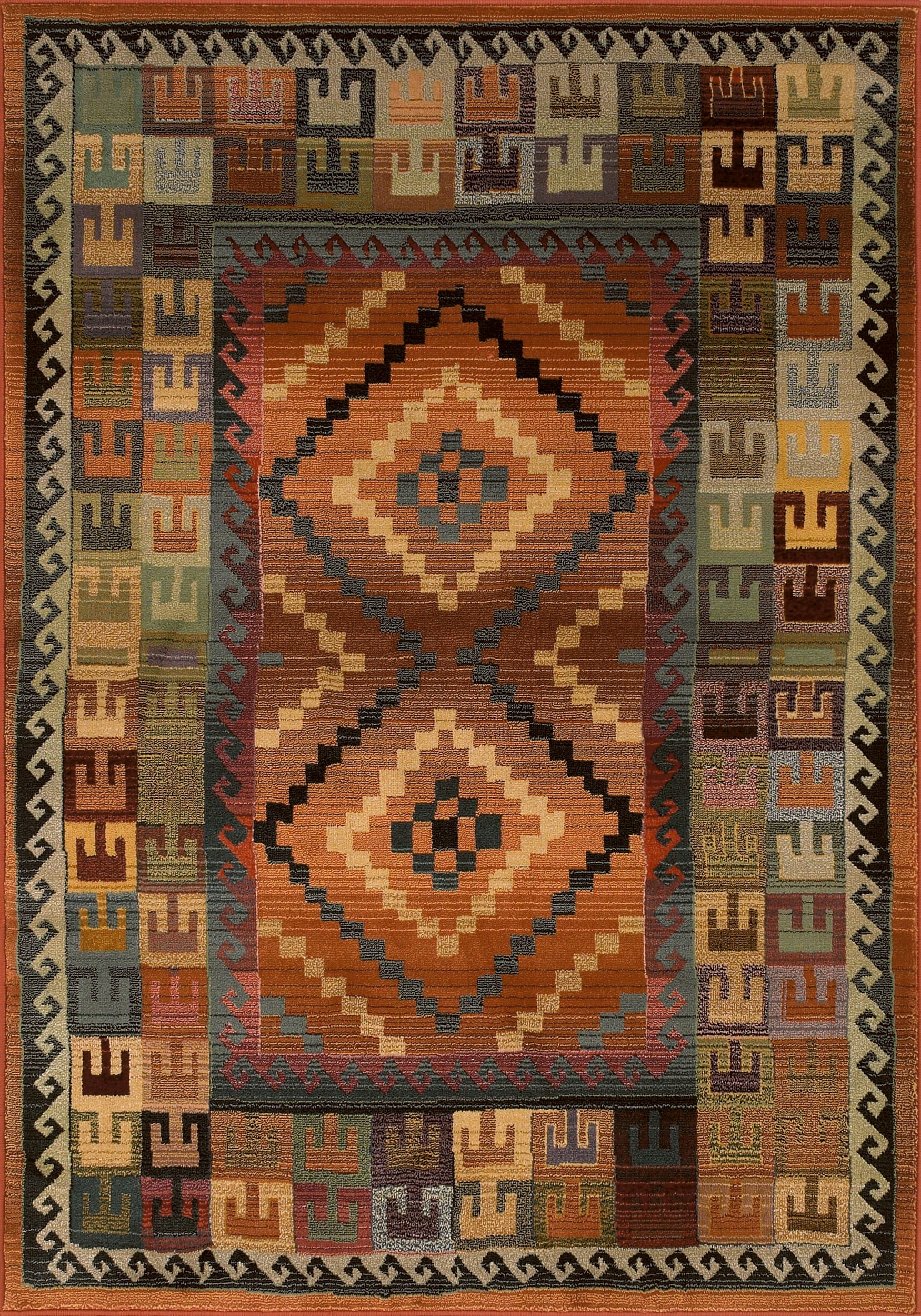
Ultimate guide to buy a Gabbeh
It is interesting to know that Gabbeh rugs do not have any pre-defined designs. But weavers weave it by designs that originate from their mind and it is completely an imaginary work, whether animals or landscapes. The largest size of Gabbeh to buy is four and a half meters.
Buy a Gabbeh
Gabbeh is a type of carpet, that is, it has pile besides weft and warp, but rug dealers do not consider Gabbeh as a carpet when dividing carpet types and refer it to as one of the types of rugs, perhaps because of the thickness of the pile and its knot length that is longer and thicker in comparison with Carpet types.
The handmade Gabbeh is a handiwork of the nomads of Fars province and is now custom-made in urban carpet weaving workshops. Gabbeh has no plan and his designs are imaginary; it means, the Gabbeh weaver imagines its design in his mind from the landscapes he sees, the sketch of an animal, human, and tree or even geometric sketches.
IRAN ART EXHIBITION: The dimension of Gabbeh is usually from one and a half (1.5) to four and a half (4.5) meters, and larger than this size is almost impossible to find in the market.
Gabbeh is a heavy carpet because of its thick pile and big knots, and also because of its knots are loose, it has soft pile.
1- Since the mid-1980s, because of the subject of Gabbeh in several films, the Gabbeh fever breakout started in the market, and the price of it rocketed up and became even more expensive than some of the Kashan and Arak carpets, but after that period, Gabbeh fever cooled and prices fell down. Now, prices are good and fair. By the way, one of the most artistic types of Gabbeh is a Gabbeh made of sheep’s wool, it means, a weaver knot it by pure sheep wool without any dye. This type of Gabbe is very resistant to moisture and direct sunlight and does not change its color and ofcourse is very beautiful. When you are going to buy a Gabbeh, remember to have a wet textile.
2. You should roll the Gabbeh in tubular form. The worst way to shrink a Gabbeh is to fold it, Although it will use less space but this method makes the Gabbeh break. If the dust and soil stays in Gabbeh piles for a long time and you do not clean it, it will harden the carpet and break it down.
3 — With a vacuum cleaner in today’s life, there is little chance that termite damage the carpet , but if you are going to keep carpet in your wardrobe or a corner of your home for some time, to avoid termite damage use naphthalene.
4. If you wash large carpets and Gabbehs with carpet shampoo, they will stay healthy and well cleaned, but fine and artistic rugs and small carpets should be washed with carpet shampoo and hand-washed and if you wish, you can wash it in the washing machine with cold water. Remember, do not throw them in the washing machine with clothes that have buttons and zip. Do not use laundry powders, but instead use liquid detergent that is useful for color clothes; the water temperature should not be too high, which is below 30 degrees Celsius.
The effect of sun on the Gabbeh
If Gabbeh or kilim fibers have a natural color or dye, they will not be harmed by direct sunlight exposure, but fibers that are chemically dyed – especially if they have bad quality, will quickly pale in the exposure of direct sunlight.
To distinguish the natural color from the synthetic and chemical color of a Gabbeh or carpet, first note that the chemical color is very dark and strong (!), But the natural color is light and bright; second, remember when you want to buy a Gabbeh, rub it with a piece of damp white cloth or a piece of wet sponge.
IRAN ART EXHIBITION: If it is colored, it means it is chemical color or dye. When washing your Gabbeh with shampoo, be careful to clean the Gabbeh piles as well. To take care of Gabbeh piles from decaying is very important because it reduce the value of Gabbeh.
